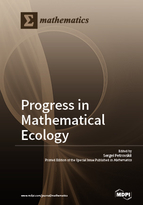Progress in Mathematical Ecology
A special issue of Mathematics (ISSN 2227-7390).
Deadline for manuscript submissions: closed (31 March 2018) | Viewed by 76869
Special Issue Editor
Interests: mathematical ecology; theoretical ecology; biological invasions; spatial ecology; movement ecology
Special Issues, Collections and Topics in MDPI journals
Special Issue Information
Dear Colleagues,
Mathematical ecology is an area of applied mathematics concerned with applications of mathematical concepts, tools and techniques, usually in the form of mathematical models, to problems arising in population dynamics, ecology and evolution. Mathematical modelling in ecology plays a very special role. Due to a very high complexity of ecological systems and the transient nature of the environment conditions, regular, replicated experimental studies are not always possible. Mathematical modelling creates a virtual laboratory where different hypotheses can be tested and different scenarios of ecological dynamics can be considered and studied in detail, as a complement (and sometimes even as a substitute) to empirical research. This Special Issue is designed to give a snapshot of the state of the art in mathematical ecology. Topics of interest are given by (in no particular order) biological invasions, biological control, ecological pattern formation, ecologically relevant multiscale models, food webs, individual movement and dispersal, eco-epidemiology, evolutionary ecology, agroecosystems, regime shifts and early warning signals, synchronization and chaos. The list of inclusive, rather than exclusive, and other relevant topics may be considered. We expect high quality papers containing new, unpublished results making new insight into problems of ecology and population dynamics.
Prof. Dr. Sergei PetrovskiiGuest Editor
Manuscript Submission Information
Manuscripts should be submitted online at www.mdpi.com by registering and logging in to this website. Once you are registered, click here to go to the submission form. Manuscripts can be submitted until the deadline. All submissions that pass pre-check are peer-reviewed. Accepted papers will be published continuously in the journal (as soon as accepted) and will be listed together on the special issue website. Research articles, review articles as well as short communications are invited. For planned papers, a title and short abstract (about 100 words) can be sent to the Editorial Office for announcement on this website.
Submitted manuscripts should not have been published previously, nor be under consideration for publication elsewhere (except conference proceedings papers). All manuscripts are thoroughly refereed through a single-blind peer-review process. A guide for authors and other relevant information for submission of manuscripts is available on the Instructions for Authors page. Mathematics is an international peer-reviewed open access semimonthly journal published by MDPI.
Please visit the Instructions for Authors page before submitting a manuscript. The Article Processing Charge (APC) for publication in this open access journal is 2600 CHF (Swiss Francs). Submitted papers should be well formatted and use good English. Authors may use MDPI's English editing service prior to publication or during author revisions.
Keywords
- Biological invasion
- Biological control
- Pattern formation
- Individual animal movement
- Dispersal
- Agroecology
- Food web
- Transients
- Resilience
- Regime shift
- Synchronization
- Bifurcation
- Chaos
Benefits of Publishing in a Special Issue
- Ease of navigation: Grouping papers by topic helps scholars navigate broad scope journals more efficiently.
- Greater discoverability: Special Issues support the reach and impact of scientific research. Articles in Special Issues are more discoverable and cited more frequently.
- Expansion of research network: Special Issues facilitate connections among authors, fostering scientific collaborations.
- External promotion: Articles in Special Issues are often promoted through the journal's social media, increasing their visibility.
- e-Book format: Special Issues with more than 10 articles can be published as dedicated e-books, ensuring wide and rapid dissemination.
Further information on MDPI's Special Issue polices can be found here.






